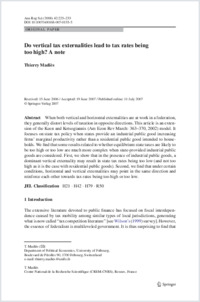Do vertical tax externalities lead to tax rates being too high? A note
BP2-STS
- Madiès, Thierry University of Fribourg
- 2007
Published in:
- The Annals of Regional Science. - 2007, vol. 42, p. 225-233
English
When both vertical and horizontal externalities are at work in a federation, they generally distort levels of taxation in opposite directions. This article is an extension of the Keen and Kotsogiannis (Am Econ Rev March: 363–370, 2002) model. It focuses on state tax policy when states provide an industrial public good increasing firms’ marginal productivity rather than a residential public good intended to households. We find that some results related to whether equilibrium state taxes are likely to be too high or too low are much more complex when state-provided industrial public goods are considered. First, we show that in the presence of industrial public goods, a dominant vertical externality may result in state tax rates being too low (and not too high as it is the case with residential public goods). Second, we find that under certain conditions, horizontal and vertical externalities may point in the same direction and reinforce each other towards tax rates being too high or too low.
- Faculty
- Faculté des sciences économiques et sociales et du management
- Department
- Département d'économie politique
- Language
-
- English
- Classification
- Economics
- License
-
License undefined
- Persistent URL
- https://folia.unifr.ch/unifr/documents/320370
Statistics
Document views: 81
File downloads:
- 2007_Madies_Vertical: 102
